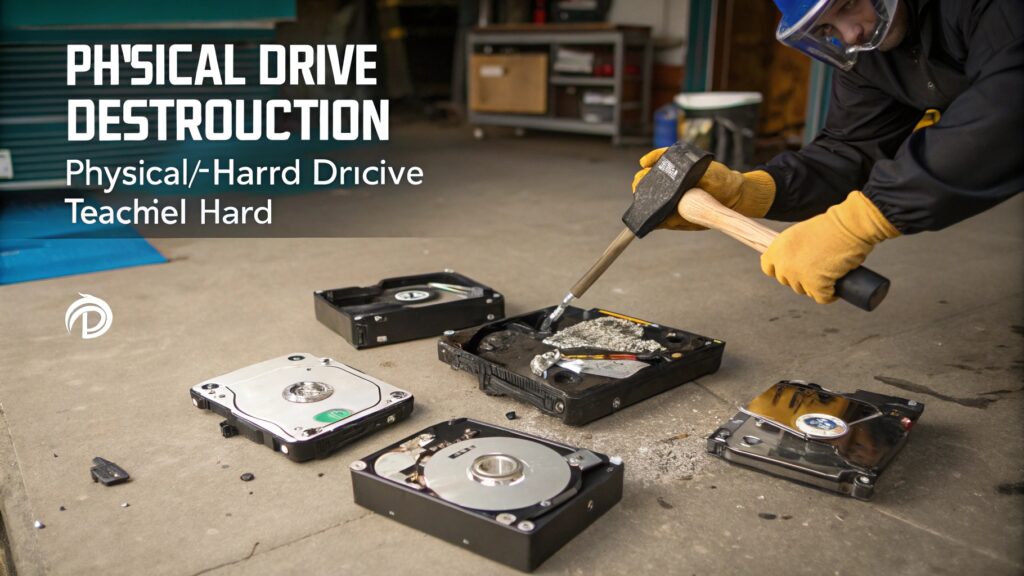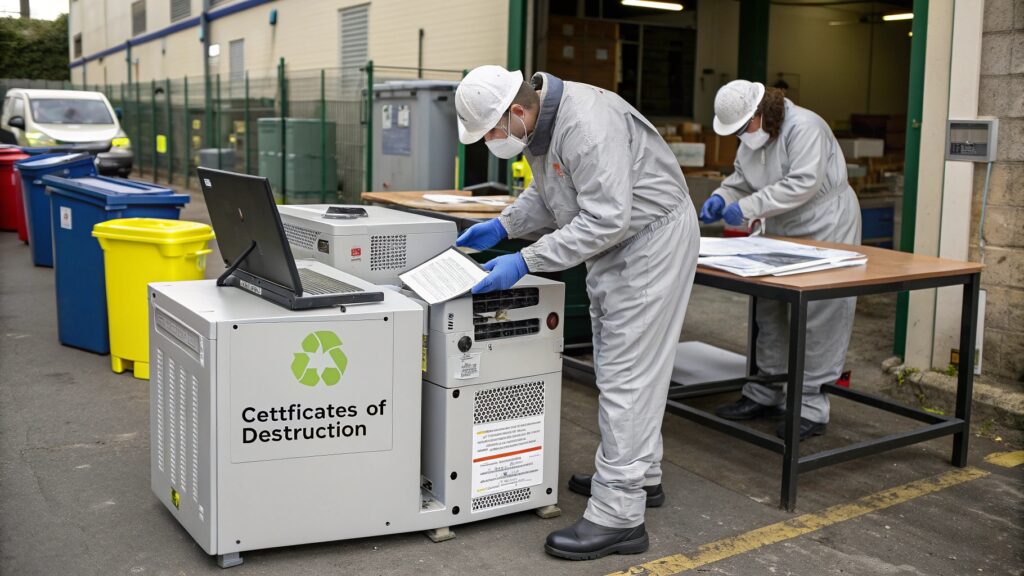In today’s digital world, our personal and business information lives on hard drives. When those drives are no longer needed, proper hard drive data destruction becomes essential. Whether you’re an individual protecting your identity or a business ensuring compliance, destroying data the right way is crucial to avoid serious consequences, such as identity theft, data breaches, and legal penalties.
This guide is written in simple English, targeting readers in the USA who want to understand everything about hard drive data destruction. We’ll explore methods, best practices, professional options, legal guidelines, and answer common questions. Our aim is to make this the most comprehensive, human-friendly, and Google-optimized resource available.
What Is Hard Drive Data Destruction?
Hard drive data destruction is the process of permanently removing all data stored on a hard drive so that it can never be recovered or accessed again. This is much more thorough than simply deleting files or formatting the drive, which only removes file pointers without erasing the actual data. Effective data destruction ensures that sensitive information—such as personal identities, financial details, medical records, or business files—cannot be retrieved by unauthorized individuals.
It is an essential practice for protecting privacy, preventing data breaches, and complying with laws and regulations like HIPAA, GDPR, and others. Methods for hard drive data destruction include physical techniques like shredding, crushing, and degaussing, as well as software-based options that overwrite every part of the drive. Whether for personal, corporate, or government use, secure data destruction gives peace of mind that confidential information is truly gone for good.
Also Read: Computer Disposal Services – Legal & Hassle-Free Recycling!
Key Methods of Hard Drive Data Destruction — You Must Know!

Physical Destruction:
Physical destruction is one of the most reliable ways to ensure that no data can ever be retrieved. It involves destroying the actual hardware of the drive, making recovery impossible—even with advanced forensic tools.
- Shredding: The hard drive is fed into an industrial shredder that grinds it into tiny pieces. This is often considered the most foolproof method.
- Crushing: A hydraulic press or crusher is used to crush and puncture the platters inside the drive, damaging its ability to function.
- Shearing: Industrial shearers slice through the hard drive, destroying both the outer casing and internal components.
- Melting or Incineration: The drive is subjected to extremely high temperatures in a furnace, reducing it to scrap metal and ashes.
Physical methods are best used when data must be destroyed beyond doubt, especially in industries that handle confidential or classified information.
Degaussing (Magnetic Field Disruption):
Degaussing is a method that uses powerful magnetic fields to disrupt the magnetic domains that store data on hard disk drives (HDDs). When done correctly, it effectively erases all data instantly.
However, degaussing:
- Works only on magnetic drives (HDDs), not on solid-state drives (SSDs).
- Renders the drive completely unusable afterward.
- Requires professional-grade equipment due to the strength of the magnets needed.
Degaussing is highly effective in environments where destroying multiple magnetic drives quickly is required.
Software-Based Data Erasure:
This method involves using specialized software to overwrite all the data on the drive with a pattern of random characters, zeroes, or ones. It’s also known as data wiping or secure erase.
Key points:
- Leaves the drive usable afterward—ideal for resale or recycling.
- Can meet government and industry standards if certified tools are used.
- May not completely wipe all data on SSDs due to the way flash memory stores information.
This method is best for individuals and businesses that want to reuse hardware while still protecting data.
Hybrid Approaches (Combining Methods):
Some professionals use a combination of methods to ensure total data destruction. For example:
- Running a secure erase first, then physically crushing the drive.
- Degaussing a drive and then shredding it for added assurance.
Hybrid approaches are often used in military, government, and legal industries, where information sensitivity is extremely high and compliance is non-negotiable.
Professional Destruction Services:
Many organizations choose to outsource the task to certified data destruction companies. These services:
- Use industrial-grade equipment.
- Provide a certificate of destruction for legal and compliance purposes.
- Often include environmentally responsible e-waste recycling.
This is a smart option for businesses that regularly dispose of large volumes of drives or need documented proof of destruction.
What Are the Legal and Compliance Aspects of Hard Drive Data Destruction?
- Legal Requirements: Some laws require you to destroy old data safely.
- Privacy Protection: These laws protect private or personal information.
- Important Laws: Important laws include HIPAA, GDPR, FACTA, and others.
- Penalties: If you break these rules, you can be fined or sued.
- Proof of Destruction: Businesses may need a Certificate of Destruction as proof.
- Professional Help: Hiring a professional service helps you follow the law.
- Trust & Security: Safe data destruction keeps your company trusted and protected.
- Environmental Responsibility: Proper destruction ensures eco-friendly disposal of electronic waste.
- Audit Preparedness: Proper records help companies pass audits and inspections.
- Risk Reduction: Secure destruction reduces the chance of data breaches and identity theft.
Must Check: Computer Recycling – A Complete Guide!
What Are the Most Effective Physical Hard Drive Destruction Techniques?

Shredding: The Ultimate Destruction Method
Shredding is widely considered the most secure way to physically destroy a hard drive. Industrial shredders tear the drive into tiny metal and plastic fragments, making any data recovery impossible. This method is especially favored by government agencies and large corporations. It’s fast, reliable, and leaves no room for error when done by certified professionals.
Crushing: Quick and Reliable for On-Site Destruction
Crushing involves using a heavy-duty press or specialized crusher to deform the hard drive’s platter and casing. Once the internal components are bent or broken, retrieving data becomes nearly impossible. This method is great for quick on-site destruction, especially for businesses that need to dispose of drives in real time without moving them off-premises.
Shearing: Precision Cutting for High-Volume Drives
Shearing uses industrial metal blades to slice through hard drives with precision. It’s ideal for companies that process hundreds or thousands of drives regularly. Each drive is cut in a way that destroys the platter and electronic board at once. The clean cuts also make it easier to recycle the remaining materials responsibly.
Incineration and Melting: Extreme Heat for Complete Annihilation
This technique involves subjecting hard drives to extremely high temperatures until they melt or burn to ash. Melting or incineration guarantees total destruction, especially for highly confidential or classified data. However, it requires specialized equipment and must follow strict environmental safety protocols due to the toxic fumes and residues it can produce.
DIY Physical Destruction: Risks and Limitations
Some individuals attempt to destroy hard drives at home using drills, hammers, or fire. While these methods may damage the drive, they rarely destroy all the data-bearing components. DIY attempts can also be dangerous and lack documentation for legal compliance. For sensitive or regulated data, professional methods are always the safer choice.
How to Choose the Right Method?
| Scenario | Recommended Method | Reason |
| Disposing personal home computer | Software Erasure or Crushing | Cost-effective and simple; adequate for most personal data |
| Large enterprise with sensitive data | Shredding + Certificates | Ensures compliance and total data destruction |
| Healthcare provider with HIPAA data | Physical Destruction | Required by law; safest for patient confidentiality |
| Dealing with SSDs | Shredding or Shearing | Overwriting fails; only physical destruction works |
| Need to reuse drives securely | Certified Software Erasure | Keeps drive functional while removing all traces of data |
| Financial sector (FATCA compliance) | Shredding + Documentation | Meets regulatory and audit standards |
| Environmentally responsible disposal | Software Erasure + E-Waste Recycling | Keeps drives out of landfills and reduces toxic waste |
| Remote workers sending in devices | Mail-in Destruction Services | Secure method with tracking and Certificates of Destruction |
Recent Post: Computer Recycling Leicester – Safe Data Wipe & Fast Service!
Why Choose Professional Destruction Services?

Choosing professional destruction services ensures that your hard drive data is destroyed safely, securely, and in full compliance with legal requirements. These experts use industrial-grade equipment that guarantees complete data destruction, far beyond what typical consumer methods can achieve.
Additionally, professional services provide valuable documentation, such as certificates of destruction, which serve as legal proof that your data was properly disposed of. This is especially important for businesses that must meet strict regulatory standards.
Beyond security and compliance, professional companies also handle the environmentally responsible recycling or disposal of electronic waste, helping reduce your organization’s environmental impact. Overall, hiring professionals gives you peace of mind that your sensitive information is irretrievably destroyed without risk.
FAQs:
Can I destroy a hard drive with a hammer?
Using a hammer may physically damage the drive, but it usually won’t destroy all the data completely. Small fragments of data could still be recovered, so this method is not reliable for secure destruction.
Does erasing my hard drive remove all viruses?
Properly erasing a hard drive using secure wiping software can remove viruses by overwriting all data. However, physical destruction is the only way to guarantee that no data, including viruses, can survive.
Is formatting the same as data destruction?
No, formatting only deletes the file system pointers but leaves the actual data intact and recoverable with specialized tools. True data destruction requires overwriting or physically destroying the storage media.
Are SSDs harder to destroy than HDDs?
Yes, SSDs store data differently, making it harder to completely erase all information using software alone. Physical destruction is often recommended for SSDs to ensure all data is permanently destroyed.
Can I reuse a drive after data erasure?
Yes, if you use certified data erasure software that securely overwrites every sector, the drive remains usable. This method is ideal for those who want to resell or reuse drives without risking data leaks.
Conclusion:
Proper hard drive data destruction is essential to protect sensitive information, comply with legal regulations, and prevent data breaches. While simple deletion or formatting is not enough, various methods like physical destruction, degaussing, and software-based erasure offer different levels of security and usability. For highly sensitive data, especially on SSDs, physical destruction by professionals provides the highest assurance of complete data removal.
Latest Post:


